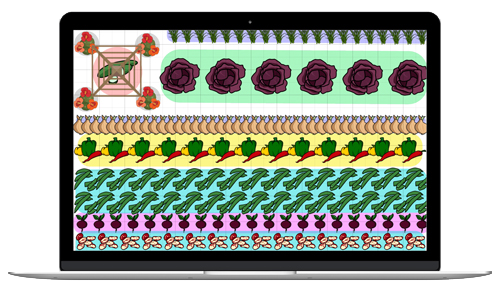
Blueberries are one of the easiest fruits to grow.
Planting, Growing, Pruning, and Harvesting Blueberries
The Almanac Garden Planner - Use It Free for 7 Days!
Plan your 2025 garden with our award-winning Garden Planner.
Types
Blueberries are partially self-fertile, so you will harvest more and larger berries by planting two or more varieties together. Planting more than one variety can also extend the harvest season.
Highbush (Vaccinium corymbosum): A six-foot shrub hardy from Zone 4 to Zone 7.
- For withstanding cold winters, choose ‘Bluecrop’, ‘Blueray’, ‘Herbert’, ‘Jersey’, or ‘Meader’.
- For big berries, choose ‘Berkeley’, ‘Bluecrop’, ‘Blueray’, ‘Coville’, ‘Darrow’, or ‘Herbert’.
- For flavor, usually, the main reason for growing your own fruit, choose ‘Blueray’, ‘Darrow’, ‘Herbert’, ‘Ivanhoe’, ‘Pioneer’, ‘Stanley’, or ‘Wareham’.
- For something different, try ‘Pink Lemonade’, which produces bright pink blueberries!
Lowbush (Vaccinium angustifolium): For the coldest climates, lowbush varieties are your best bet, hardy from Zone 3 to Zone 7.
- These are the blueberries you find in cans on supermarket shelves. When fresh, the fruits are sweet and covered with a waxy bloom so thick that the berries appear sky blue or gray.
- The creeping plants, a foot or so high, are spread by underground stems, or rhizomes. They blanket the rocky upland soils of the Northeast and adjacent portions of Canada. Lowbush blueberries make a nice ornamental fruiting ground cover.
- Plants sold by nurseries are usually seedlings or unnamed wild plants rather than named varieties.
Half-High: Breeders have combined qualities of highbush and lowbush blueberries into hybrids known as half-high blueberries.
- The University of Minnesota introductions include ‘Northcountry’,v a variety that grows 18 to 24 inches high and has excellent, mild-flavored, slightly aromatic sky-blue fruits; and ‘Northblue’, which grows 20 to 30 inches high and produces an abundance of dark-blue, nickel-size, somewhat tart fruits-just right for pies.
- ‘Northland’ is a half-high that grows 3 to 4 feet tall. From Michigan, it has relatively bland, average-quality fruit.
Blueberries for Southern Gardens (Zones 7–9):
- Rabbiteye (Vaccinium virgatum): Grown in the southeastern United States, rabbiteye varieties are extremely adaptable, productive, and pest-tolerant. They do, however, have a high degree of self-incompatibility and require two or more varieties to be planted together to ensure pollination. Recommended varieties include ‘Powderblue’, ‘Woodard’, and ‘Brightwell’.
- Southern Highbush (hybrids of V. virgatum, V. corymbosum, or V. darrowii): Southern highbush varieties tend to be pickier and harder to grow than rabbiteyes, but there are a few high-quality varieties that do well. Among these are ‘Emerald’, ‘Windsor’, and ‘Springhigh’.
- Read more about blueberries for southern gardens from the University of Florida: Blueberry Gardener’s Guide.
ADVERTISEMENT
Blueberries need as much sun as possible to produce well. They are also picky about the soil. Please see our planting advice at top of this page. Sunshine Blue is a nice variety for warmer climates and will produce lots of berries.
Hello,
I would like to know, if it is possible to grow blueberry small bushe hydroponically? Can i get berries all year long in a closed environment with 16 hours grow lights? how much berries can i get, if i could keep the growth 365 day?
Thank you very much in advance.
Alex
Hi Alex,
Blueberries can be grown hydroponically. Please go to http://luv2garden.com/hydroponic_blueberries.html and http://gardenious.com/tag/hydroponic-blueberries/ to read more about how to succeed.
Hi, I plan on buying some blueberry plants. One area I'd like to
try in my yard doesn't get Sunlight until 1pm then gets sun until sundown.
In the summer that is 1pm to 8pm, about 7 hours. Is sunlight starting at 1pm
not enough?
Hi, jj: Much of this depends on whether they would be getting direct sunlight. Seven hours in the second half of the day is somewhat pushing the envelope for success, but it certainly might be possible. Another possibility might be to plant bushes in containers and move them (such as on a child’s wagon) to get maximum sunlight. If it were up to us, we would definitely try it with a couple of bushes as a test. Good luck!
We planted a variety of 4 blueberry bushes in our yard this spring (2015). We realized halfway through the summer they had been planted too close (in a line about 2ft apart). What is a safe way to dig them up and spread them a little furthur apart? We live in Southern Louisiana and were planning on waiting until late December, January, or February, the coldest part of the year for us, when we thought the bushes would be dormant. What is the best way to do this without damaging the plants? Thanks!
Yes, transplant when the bushes are dormant, usually after the first frost of the fall/winter. Make sure to dig far enough around the root ball and deep down to get as much of the roots as possible. Have the new holes dug and ready for the bushes.
How much & how often can i add 20% Iron Sulfate to each Blueberry Bush to lower the P/H , i have added some Elemental Sulfur, about 2 months ago & Pine bark Fines and pine Mulch . I keep checking the P/H but everything is very slow in falling, so i bought some 20% Iron Sulfate... So i need to know how to apply it, i think 2 Tbsp's per Bush , per month is correct? But i am not for SURE? Can you help me? Thank You Jerry
The acidification process with elemental sulfur is slow and can take up to 6 months. It works faster when the soil is warm. Wait until spring to test the soil again and see what the values are. If you still think you need to use the iron sulfate use about 2 tablespoons per bush.
Should I cover my 1 yr old high bush blueberries this fall to help protect from northern new hampshire winter? they are still very very small.














